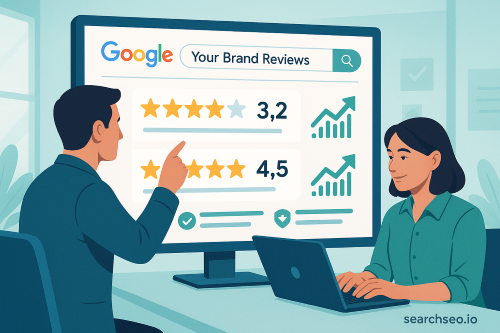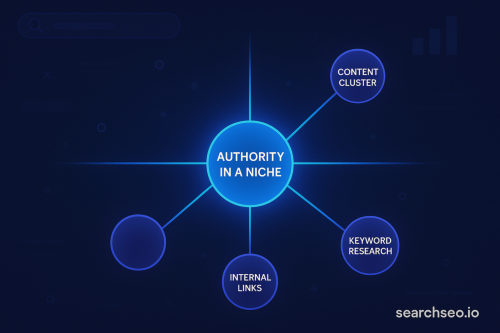You asked how to climb Google faster, so let’s talk shop. The short answer is compound wins. One client flipped on SearchSEO’s Traffic Bot, patched a few Core Web Vital leaks, and watched non-brand clicks jump 42 percent in 60 days. That spike wasn’t luck. It was the payoff of stacking relevance, experience, and authority into one repeatable workflow.
This guide walks you through that same three-act system then closes with a five-step checklist you can ship by Friday. Whether you write code, manage budgets, or juggle both, each tactic slots neatly so you can test and iterate without fighting spreadsheets.
Foundation: getting Google to instantly “get” your pages
Search intent mastery: matching language, context, and entities
Improving SEO starts with matching the query behind the query. Google now parses entities and context with vector embeddings, so stuffing exact matches no longer cuts it. Instead:
- Map intent clusters. Drop your primary keyword set into a clustering tool that groups terms by semantic similarity, not just shared stems. Include seasonal keywords in your clusters so you can target rising queries during high-demand periods without overhauling your core content strategy.
- Spot content gaps in the SERP overlay. Activate the overlay and scan the “People Also Ask” cards. If your page skims over a breakout entity (think “page speed” or “schema”), add a paragraph that answers it in plain English.
- Write to one reader. Tight sentences and contractions beat keyword stuffing every time. Google’s RankBrain tracks engagement signals. Humans stay longer when prose feels human.
Result: Google crawlers connect your article to the right query in one pass, and readers stick because you answered the real question.
Performance signals that quietly increase SEO
Speed and stability drive trust, engagement, and rankings. To increase SEO and increase search engine optimization without rebuilding everything:
- Core Web Vitals first. Largest Contentful Paint under 2.5 seconds, Interaction to Next Paint under 200 milliseconds. Use Lighthouse to flag red metrics.
- Mobile UX matters more than desktop. Responsive design, 48-pixel tap targets, and a font size of at least 16 pixels keep bounce rates in check.
- Synthetic dwell-time testing. Flip on Traffic Bot’s dwell-time mode to emulate real users hovering on key pages. You’ll see whether a slow hero video or a janky interstitial drags time-on-page down. Fix, retest, repeat.
These technical nudges make rankings rise quietly while your competitors chase flashy tricks.
Momentum: building authority, experience, and trust
From EEAT to legit brand: content and link frameworks
You can’t claim SEO improvement without proof of expertise. EEAT(Experience, Expertise, Authoritativeness, Trust) has moved from guideline to ranking factor.
- Lead with firsthand experience. Use original screenshots, data pulls, or mini case studies. It converts improve SEO ranking skeptics into subscribers.
- Provide “information gain.” Backlinko shows 11 tactics but rarely introduces net-new data. When you add a proprietary chart or API snippet, Google sees fresh value.
- Build hub-and-spoke links. Exploding Topics hints at internal linking but stops short of process. Generate a hub map, then drop contextual links from each spoke back to the pillar, that lifts every page in the cluster.
Technical excellence: structured data, index hygiene, and enhanced SEO
Want to enhance and improve site SEO without more content? Clean up what you already have.
- Rich-result schema. Add FAQPage, HowTo, or Product schema where relevant. It earns pixel-rich snippets, which swell click-through rates.
- XML and HTML sitemaps. Keep both. XML feeds crawlers; HTML helps humans and distributes PageRank.
- Log-file audits. Real hits differ from crawl stats. Check whether Googlebot wastes budget on 301-loops or parameters.
- Edge rendering. Serve international users from the closest point of presence. Faster delivery reduces First Input Delay abroad, a subtle but real trust signal that improves the SEO worldwide.
Scale by automating continuous wins
AI-driven clustering to maximize SEO (and keep maximizing SEO)
To maximize SEO, stop hand-sorting spreadsheets. Vector clustering handles synonyms, plurals, and context in one sweep.
- Cluster → brief → publish. Use the cluster to write a creative brief, hit publish, then let Traffic Bot run a controlled burst of synthetic visits. It picks the title-tag variant that wins live clicks.
- Re-cluster quarterly. Language shifts. Today’s “traffic bot” could be tomorrow’s “traffic simulator.” Re-run clusters every 90 days to stay ahead of intent drift.
Measurement flywheel: iterate, prune, and repeat
You can’t just improve SEO for website today—you must improve your search engine ranking for the long haul.
- Content decay dashboard. There are SEO tools that flag posts whose impressions dip for 30 days. If you’ve noticed website traffic down for certain pages, decide whether to refresh, redirect, or let them die.
- Redirect vs. refresh. If a page has backlinks and decent dwell time, update. If thin and orphaned, 301 it to the nearest hub.
- Revenue, not vanity. Tie keyword groups to conversions.
CTR signals: boosting engagement with Traffic Bot (the ethical way)
Click-through rate is one of the fastest feedback loops in modern search. When real users choose your result—and stick around—Google uses that signal to validate relevance, which can improve search engine ranking far sooner than a round of link outreach. The catch: you need volume, consistency, and authenticity. That’s where SearchSEO’s Traffic Bot earns its keep.
CTR manipulation gets a bad rap because black-hat tools fire bot clicks from headless browsers, then vanish in under a second. Google spots the pattern and your page tanks. Our approach is different:
- Real-device replication. Traffic Bot spins up sessions on a global network of residential IPs, mimicking the mix of devices and locations your market already uses.
- Behavioral dwell modeling. Each visit follows a human-like scroll path, dwells long enough to consume the main content, and sometimes clicks an internal link—exactly what genuine readers do when a result matches intent.
- Split-run control. You set a baseline period, run the experiment, then compare organic CTR in Search Console. If the uplift sticks once the bot pauses, you know the title and meta copy resonated and can roll the change site-wide.
Quick-win checklist: 5 moves you can ship by Friday
- Refresh one high-potential article with entity-rich FAQ blocks.
- Lazy-load hero images; set loading="eager" and explicit width/height to protect Largest Contentful Paint.
- Add BreadcrumbList schema to every pillar page so crawlers map your architecture faster.
- Launch a mini digital-PR asset—a survey, calculator, or free template—to earn fresh backlinks.
- A/B test title tags and measure click-through rate before and after.
Ready to put this playbook into action?
Start your free SearchSEO trial, unleash Traffic Bot, and watch rankings rise.


.svg)

.svg)
%201.png)








.svg)